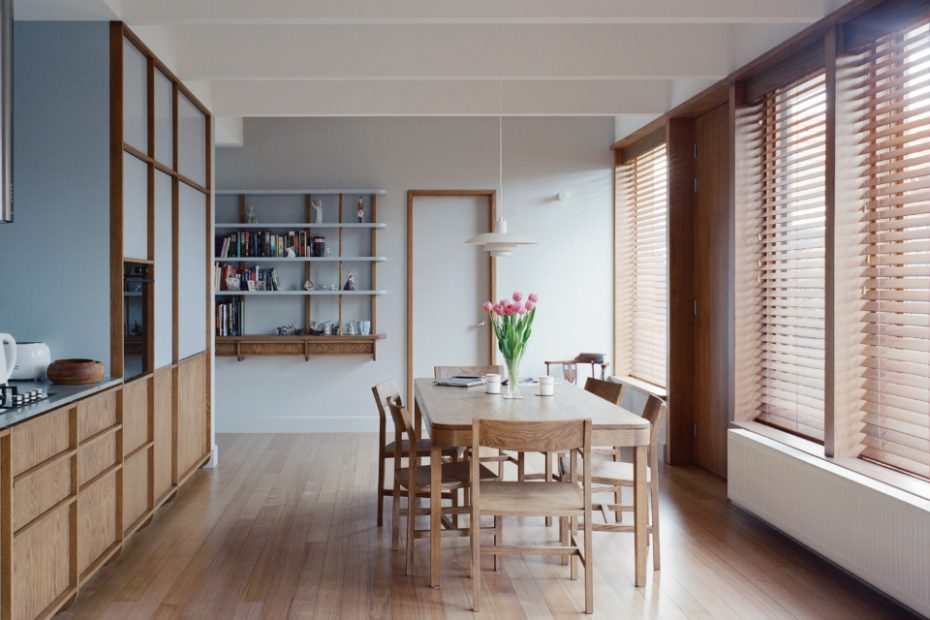This Charming Period Home Renovation Was Inspired By A Famous 1960s Hotel
Architecture
The Gardenvale home’s new living room.
Large glass windows are veiled by cedar blinds that filter sunlight when down, and capture garden views when drawn.
Recycled hardwood flooring has been integrated with the existing timber floor.
The kitchen is the new heart of the home, painted in a soft blue tone inspired by the SAS Royal Hotel in Copenhagen, Denmark.
The project’s warm materials, colour coordination, and custom joinery also channel the elegance of the rooms inside the SAS Royal Hotel.
Built-in shelves and timber furniture break up the pastel blue backdrop.
A restored bedroom features ceiling cornices overhead. Painting by Kusuaji, purchased from a gallery in Ubud, Indonesia.
Inside the playful blue bathroom.
The renovation retained the red brick exterior and worked within the existing footprint.
The blinds also provide a cloak of privacy.
The classic suburban facade doesn’t give much away about what lies inside.
This interwar home in Gardenvale was a typical suburban property that had been largely untouched, until a recent renovation by Ware Architects.
Like many homes built during the 1920s, the street-facing half of the house contained all the classic character, with red brick details, fireplaces, and elegant windows.
‘The details and charm were there, but somewhat hidden within a collection of dark rooms opening off a central corridor, all of which were completely separated from the rear garden,’ director Jono Ware says.
He’d been engaged by the long-time owner, who was looking to downsize into the residence from her ‘once large, bustling family household’ that was just next door. The brief was to create a more compact and flexible floorplan, which could easily shift between quiet, intimate spaces and more communal zones whenever her sons and their growing families came to visit.
Jono says their approach involved a ‘meticulous restoration’ of the front of the house, as the less spacious rear half was reorganised around a new kitchen, living and dining room.
A short hallway guides visitors into this open-plan area that wraps around the perimeter, making the most of the existing footprint and capturing garden views with expansive glass windows. In the kitchen, a cleverly concealed ‘wall-like’ door hidden behind the kitchen cabinetry also allows the owner to close off part of the house.
‘This allows the second bedroom and sitting room to easily switch into temporary private guest accommodation mode, with ample space for the young parents and grandkids to settle into when visiting,’ Jono says.
For the interiors, they found inspiration in a unique building from a completely different era: the SAS Royal Hotel, designed by Danish architect Arne Jacobsen, whose work Jono had come to appreciate after a stint living overseas. Built in 1960, the hotel was Copenhagen’s first skyscraper, but Jono says they were drawn to the understated elegance of the pale-blue rooms inside the famous structure, where warm materials were paired with custom joinery.
‘The resulting pale blue joinery and moveable kitchen wall is reminiscent of art deco colour palettes, which were often adorned with jewel-like blues and turquoise,’ he adds. American oak joinery and timber furniture bring a warm, natural edge to the subtle blue theme, enhanced by the cedar blinds over the large windows that bathe the interiors in a warm luxurious glow.
‘In an effort to reduce new materials where possible, recycled hardwood flooring seamlessly integrates with the existing timber floor, while salvaged red clay bricks from the demolition are repurposed to reconstruct the eastern wall and external paved terraces,’ Jono adds.
The renovation has fundamentally transformed the way the home and garden spaces are experienced — all without expanding the built footprint or it’s enduring, familiar charm.
